Oral Glucose Tolerance Test (OGTT) Evidence for the Postprandial Anti-Hyperglycemic Property of Salacca zalacca (Gaertn.) Voss Seed Extract
Abstract
:1. Introduction
2. Results
2.1. Quantitative Phytochemical Analysis by High-Performance Liquid Chromatography (HPLC)
2.2. Antioxidant Effects of Salak Seed Extract In Vitro
2.3. Hypoglycemic Effects of Salak Seed Extract In Vitro
2.3.1. Glucose Uptake in Caco-2 Cells
2.3.2. α-Glucosidase Activity
2.4. In Vivo Antihyperglycemic Activity of Salak Seed Extract
2.4.1. Oral Acute Toxicity Test
2.4.2. Oral Glucose Tolerance Tests (OGTT) of Normal and Diabetic Mice
2.4.3. Anti-Hyperglycemic Effects of Salak Seed Extract on STZ-NA-Induced Diabetic Mice after Continuous Oral Administration for 28 Days
3. Discussion
4. Materials and Methods
4.1. Identification of Plant Materials
4.2. Preparation of Salak Seed Extract
4.3. Quantification of Chlorogenic Acid by High-Performance Liquid Chromatography
4.4. Determination of Total Phenolic Content in Salak Seed Extract
4.5. Antioxidant Effects of Salak Seed Extract In Vitro
4.6. Effect of Salak Seed Extract on Malondialdehyde (MDA) Production In Vitro
4.7. In Vitro Hypoglycemic Effects of Salak Seed Extract
4.7.1. Caco-2 Cell Culture and Cell Viability Assay
4.7.2. Effect of Salak Seed Extract on Glucose Uptake in Caco-2 Cells
4.8. Effect of Salak Seed Extract on α-Glucosidase Activity In Vitro
4.9. In Vivo Antihyperglycemic Activity of Salak Seed Extract in STZ-NA-Induced DM Mice
4.9.1. Animals
4.9.2. Oral Acute Toxicity Test
4.9.3. Induction of Type 2 Diabetes in Mice
4.9.4. Oral Glucose Tolerance Testing (OGTT) in Normal and Diabetic Mice
4.9.5. Anti-Hyperglycemic Effects of Salak Seed Extract on STZ-NA-Induced DM Mice after 28-Day Continuous Daily Administration
- Normal Control group (NC): Mice in this group received water (serving as the normal control group).
- Diabetes Mellitus group (DM): Mice with diabetes administered with water.
- DM + Gli-5: Mice with diabetes administered with 5 mg/kg of glibenclamide (serving as a positive control group).
- DM + Salak-500: Mice with diabetes administered with 500 mg/kg of salak seed extract.
- DM + Salak-1000: Mice with diabetes administered with 1000 mg/kg of salak seed extract.
4.10. Statistical Analysis
5. Conclusions
Author Contributions
Funding
Institutional Review Board Statement
Informed Consent Statement
Data Availability Statement
Acknowledgments
Conflicts of Interest
Sample Availability
References
- Supapvanich, S.; Megia, R.; Salak, D.P. Salacca zalacca (Gaertner) Voss. In Postharvest Biology and Technology of Tropical and Subtropical Fruits; Yahia, E.M., Ed.; Woodhead Publishing: Cmbridge, UK, 2011; pp. 334–352. [Google Scholar]
- Hlásná Čepková, P.; Jágr, M.; Janovská, D.; Dvořáček, V.; Kotrbová Kozak, A.; Viehmannová, I. Comprehensive mass spectrometric analysis of snake fruit: Salak (Salacca zalacca). J. Food Qual. 2021, 2021, 6621811. [Google Scholar] [CrossRef]
- Kanlayavattanakul, M.; Lourith, N.; Ospondpant, D.; Ruktanonchai, U.; Pongpunyayuen, S.; Chansriniyom, C. Salak plum peel extract as a safe and efficient antioxidant appraisal for cosmetics. Biosci. Biotechnol. Biochem. 2013, 77, 1068–1074. [Google Scholar] [CrossRef]
- Haruenkit, R.; Poovarodom, S.; Leontowicz, H.; Leontowicz, M.; Sajewicz, M.; Kowalska, T.; Delgado-Licon, E.; Rocha-Guzmán, N.E.; Gallegos-Infante, J.-A.; Trakhtenberg, S.; et al. Comparative study of health properties and nutritional value of durian, mangosteen, and snake fruit: Experiments in vitro and in vivo. J. Agric. Food Chem. 2007, 55, 5842–5849. [Google Scholar] [CrossRef] [PubMed]
- Vongsak, B.; Kongkiatpaiboon, S.; Jaisamut, S.; Konsap, K. Comparison of active constituents, antioxidant capacity, and α-glucosidase inhibition in Pluchea indica leaf extracts at different maturity stages. Food Biosci. 2018, 25, 68–73. [Google Scholar] [CrossRef]
- Kim, J.K.; Park, S.U. Chlorogenic acid and its role in biological functions: An up to date. Excli. J. 2019, 18, 310–316. [Google Scholar] [CrossRef] [PubMed]
- Miao, M.; Xiang, L. Pharmacological action and potential targets of chlorogenic acid. Adv. Pharmacol. 2020, 87, 71–88. [Google Scholar] [CrossRef]
- Saleh, M.S.; Siddiqui, M.J.; Mat So’ad, S.Z.; Roheem, F.O.; Saidi-Besbes, S.; Khatib, A. Correlation of FT-IR fingerprint and α-glucosidase inhibitory activity of Salak (Salacca zalacca) fruit extracts utilizing orthogonal partial least square. Molecules 2018, 23, 1434. [Google Scholar] [CrossRef] [PubMed]
- Saleh, M.S.; Siddiqui, M.J.; So’ad, S.Z.; Murugesu, S.; Khatib, A.; Rahman, M.M. Antioxidant and α-glucosidase inhibitory activities and gas chromatography–mass spectrometry profile of salak (Salacca zalacca) fruit peel extracts. Phcog. Res. 2018, 10, 385–390. [Google Scholar] [CrossRef]
- Saleh, M.S.M.; Siddiqui, M.J.; Mediani, A.; Ahmed, Q.U.; So’ad, S.Z.; Saidi-Besbes, S.; Hassan Elnaem, M.; Othman, H.A.; Ismail, N.H. Modulation of metabolic alterations of obese diabetic rats upon treatment with Salacca zalacca fruits extract using 1H NMR-based metabolomics. Food Res. Int. 2020, 137, 109547. [Google Scholar] [CrossRef]
- Zubaidah, E.; Rukmi Putri, W.D.; Puspitasari, T.; Kalsum, U.; Dianawati, D. The effectiveness of various salacca vinegars as therapeutic agent for management of hyperglycemia and dyslipidemia on diabetic rats. Int. J. Food Sci. 2017, 2017, 872514. [Google Scholar] [CrossRef]
- Mazumdar, P.; Pratama, H.; Lau, S.E.; Teo, C.H.; Harikrishna, J.A. Biology, phytochemical profile and prospects for snake fruit: An antioxidant-rich fruit of South East Asia. Trends Food Sci. Technol. 2019, 91, 147–158. [Google Scholar] [CrossRef]
- Arief, R.W.; Asnawi, R. The use of zalacca seeds and its potential analysis as functional beverage. IOP Conf. Ser. Earth Environ. Sci. 2021, 653, 012042. [Google Scholar] [CrossRef]
- Susila, L.A.; Udayani, I.G.; Negeri, S.M. Salacca coffee made of snake fruit seed waste from Paradise Island. In Proceedings of the International Conference of Young Scientists Cluj-Napoca, Cluj-Napoca, Romania, 16–22 April 2016; pp. 16–22. [Google Scholar]
- Suastuti, N.L.; Juniari, N.K.; Widiastuti, N.M. Characteristic of salak seed coffee with French press brewing method through organoleptic test. In Proceedings of the 1st International Conference One Belt, One Road, One Tourism (ICOBOROT 2018), Palembang, Indonesia, 22–24 November 2018; Atlantis Press: Paris, France, 2019; pp. 16–20. [Google Scholar] [CrossRef]
- Munaf, E.; Hayuni, F.; Zein, R.; Suyani, H. The use of snake fruit (Salacca sumatrana) seeds powder for the removal of Cd (II), Cu (II), and Zn (II) ions from environmental water. Res. J. Pharm. Biol. Chem. Sci. 2014, 5, 1535–1543. [Google Scholar]
- Gerich, J. Pathogenesis and management of postprandial hyperglycemia: Role of incretin-based therapies. Int. J. Gen. Med. 2013, 6, 877–895. [Google Scholar] [CrossRef]
- Dimitriadis, G.D.; Tessari, P.; Go, V.L.; Gerich, J.E. α-glucosidase inhibition improves postprandial hyperglycemia and decreases insulin requirements in insulin-dependent diabetes mellitus. Metabolism 1985, 34, 261–265. [Google Scholar] [CrossRef] [PubMed]
- Bischoff, H. The mechanism of alpha-glucosidase inhibition in the management of diabetes. Clin. Investig. Med. 1995, 18, 303–311. [Google Scholar]
- Gromova, L.V.; Polozov, A.S.; Savochkina, E.V.; Alekseeva, A.S.; Dmitrieva, Y.V.; Kornyushin, O.V.; Gruzdkov, A.A. Effect of type 2 diabetes and impaired glucose tolerance on digestive enzymes and glucose absorption in the small intestine of young rats. Nutrients 2022, 14, 385. [Google Scholar] [CrossRef]
- Oktarianti, R.; Septiana, N.A.; Lelono, A. Diuretics effect of Salak (Salacca zalacca) seed extract to kidney histopathological structure of the Wistar male rats (Rattus norvegicus). Bioedukasi 2021, 19, 90–95. [Google Scholar] [CrossRef]
- Lü, J.M.; Lin, P.H.; Yao, Q.; Chen, C. Chemical and molecular mechanisms of antioxidants: Experimental approaches and model systems. J. Cell Mol. Med. 2010, 14, 840–860. [Google Scholar] [CrossRef]
- Karthikesan, K.; Pari, L.; Menon, V.P. Combined treatment of tetrahydrocurcumin and chlorogenic acid exerts potential antihyperglycemic effect on streptozotocin-nicotinamide-induced diabetic rats. Gen. Physiol. Biophys. 2010, 29, 23–30. [Google Scholar] [CrossRef] [PubMed]
- Qi, W.; Zhao, T.; Yang, W.W.; Wang, G.H.; Yu, H.; Zhao, H.X.; Yang, C.; Sun, L.-X. Comparative pharmacokinetics of chlorogenic acid after oral administration in rats. J. Pharm. Anal. 2011, 1, 270–274. [Google Scholar] [CrossRef]
- Organization for Economic Cooperation and Development (OECD). Test No 425: Acute Oral Toxicity: Up-and-Down Procedure, OECD Guidelines for the Testing of Chemicals, Section 4; Paris OECD Publishing: Paris, France, 2008. [Google Scholar] [CrossRef]
- Huxley, R.; Lee, C.M.; Barzi, F.; Timmermeister, L.; Czernichow, S.; Perkovic, V.; Grobbee, D.E.; Batty, D.; Woodward, M. Coffee, decaffeinated coffee, and tea consumption in relation to incident type 2 diabetes mellitus: A systematic review with meta-analysis. Arch. Intern. Res. 2009, 169, 2053–2063. [Google Scholar] [CrossRef] [PubMed]
- Goto, T.; Obara, M.; Aoki, S.; Okazawa, K.; Konisho, K.; Osakabe, N.; Shoji, N. Evaluation of polyphenolic content and potential antioxidant activity of Japanese cultivars of peaches, prunes, and plums based on reversed-and normal-phase HPLC and principal component analyses. ACS Food Sci. Technol. 2021, 1, 2019–2029. [Google Scholar] [CrossRef]
- Sato, V.H.; Chewchinda, S.; Parichatikanond, W.; Vongsak, B. In vitro and in vivo evidence of hypouricemic and anti-inflammatory activities of Maclura cochinchinensis (Lour.) corner heartwood extract. J. Tradit. Complement Med. 2020, 10, 85–94. [Google Scholar] [CrossRef] [PubMed]
- Gawlik, K.; Naskalski, J.W.; Fedak, D.; Pawlica-Gosiewska, D.; Grudzien, U.; Dumnicka, P.; Małecki, M.T.; Solnica, B. Markers of antioxidant defense in patients with type 2 diabetes. Oxid. Med. Cell Longev. 2016, 2016, 2352361. [Google Scholar] [CrossRef] [PubMed]
- Ghani, M.A.; Barril, C.; Bedgood, D.R., Jr.; Prenzler, P.D. Measurement of antioxidant activity with the thiobarbituric acid reactive substances assay. Food Chem. 2017, 230, 195–207. [Google Scholar] [CrossRef]
- Kikuzaki, H.; Nakatani, N. Antioxidant effects of some ginger constituents. J. Food Sci. 1993, 58, 1407–1410. [Google Scholar] [CrossRef]
- Bakar, M.H.; Lee, P.Y.; Azmi, M.N.; Syifa’Lotfiamir, N.; Mohamad, M.S.; Shahril, N.S.; Shariff, K.A.; Ya’akob, H.; Awang, K.; Litaudon, M. In vitro anti-hyperglycemic, antioxidant activities and intestinal glucose uptake evaluation of Endiandra kingiana extracts. Biocatal. Agric. Biotechnol. 2020, 25, 101594. [Google Scholar] [CrossRef]
- Li, K.; Yao, F.; Du, J.; Deng, X.; Li, C. Persimmon tannin decreased the glycemic response through decreasing the digestibility of starch and inhibiting alpha-amylase, alpha-glucosidase, and intestinal glucose uptake. J. Agric. Food Chem. 2018, 66, 1629–1637. [Google Scholar] [CrossRef]
- Goli, A.S.; Sato, V.H.; Sato, H.; Chewchinda, S.; Leanpolchareanchai, J.; Nontakham, J.; Yahuafaif, J.; Thilavechd, T.; Meesawatsoma, P.; Maitreed, M. Antihyperglycemic effects of Lysiphyllum strychnifolium leaf extract in vitro and in vivo. Pharm. Biol. 2023, 61, 189–200. [Google Scholar] [CrossRef]
- Alzaid, F.; Cheung, H.M.; Preedy, V.R.; Sharp, P.A. Regulation of glucose transporter expression in human intestinal Caco-2 cells following exposure to an anthocyanin-rich berry extract. PLoS ONE 2013, 8, e78932. [Google Scholar] [CrossRef] [PubMed]

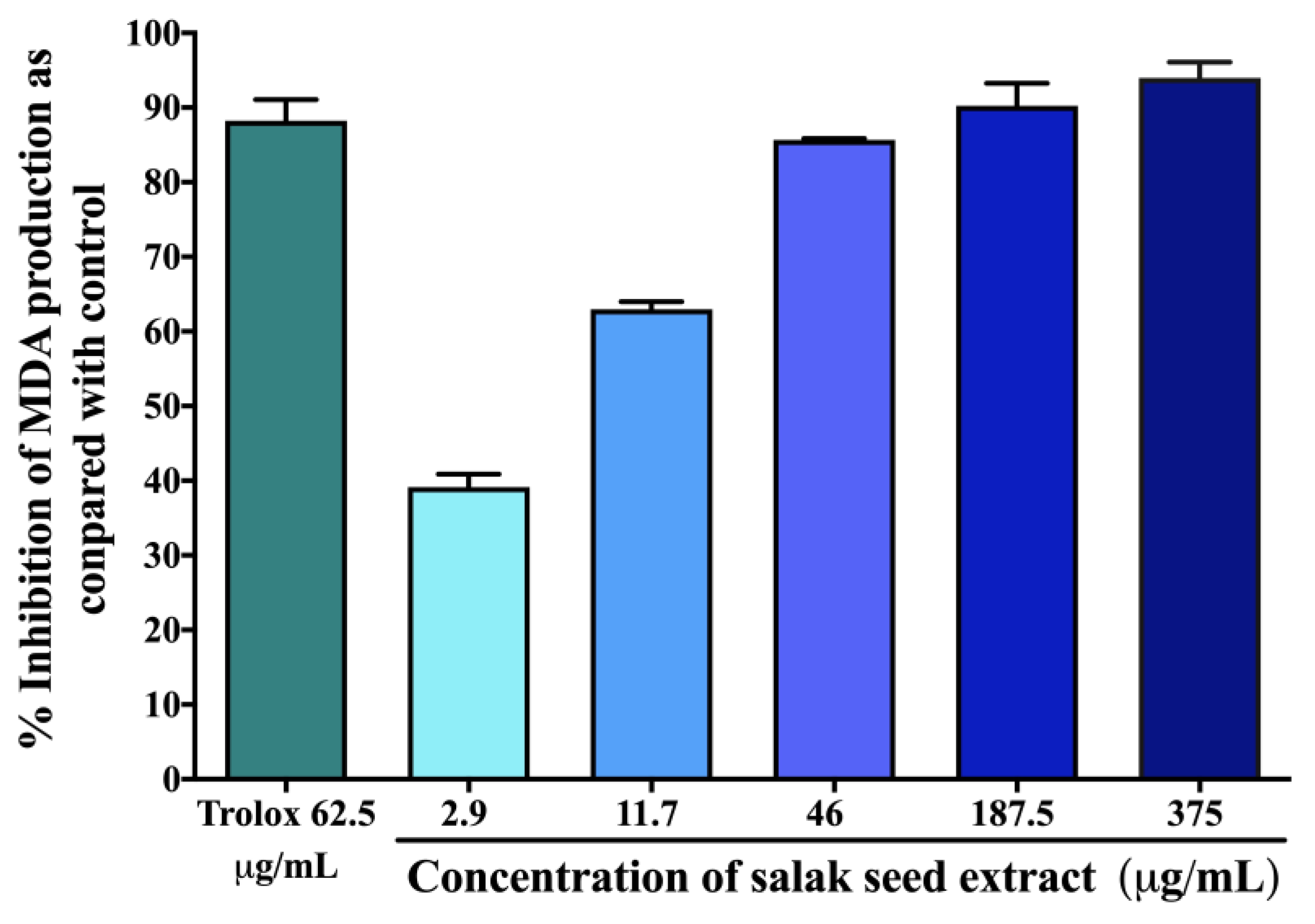

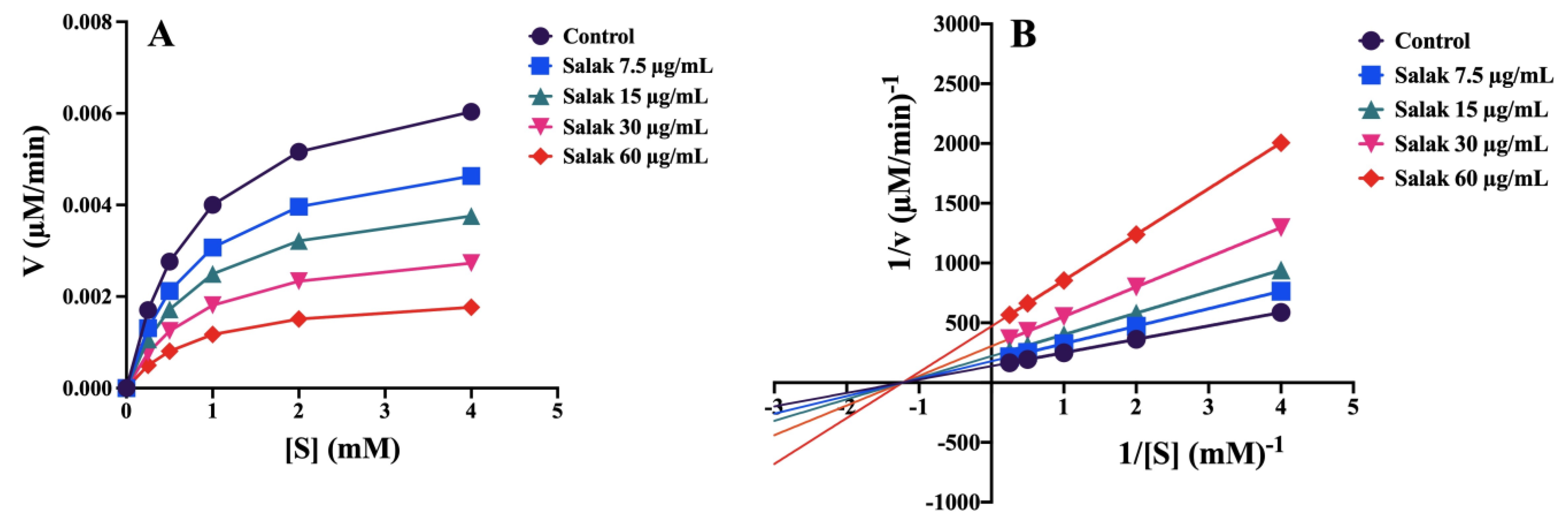

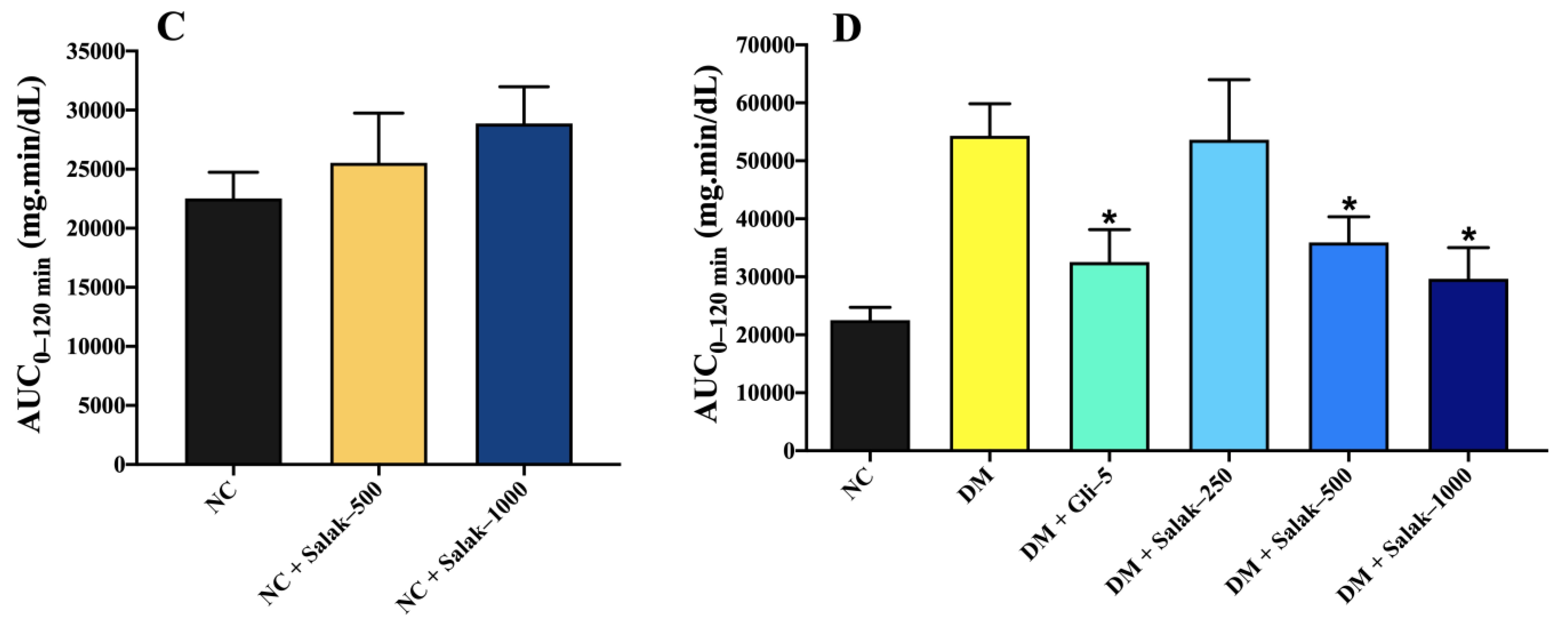
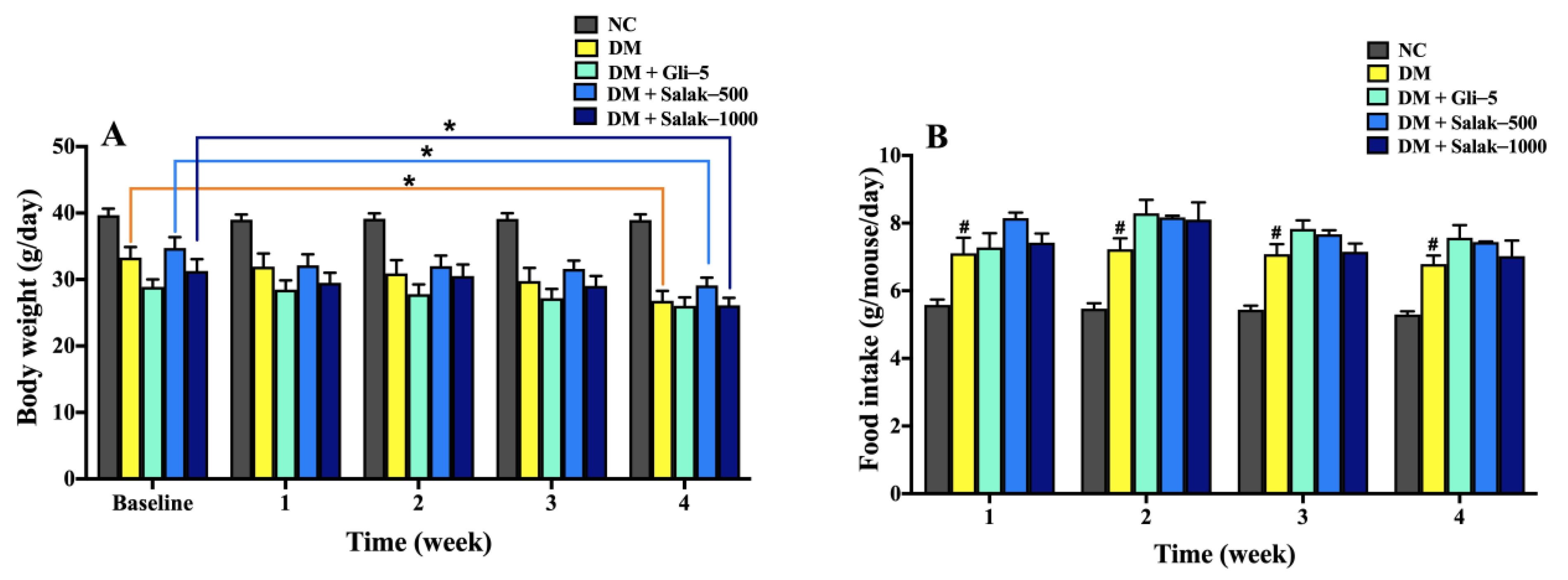
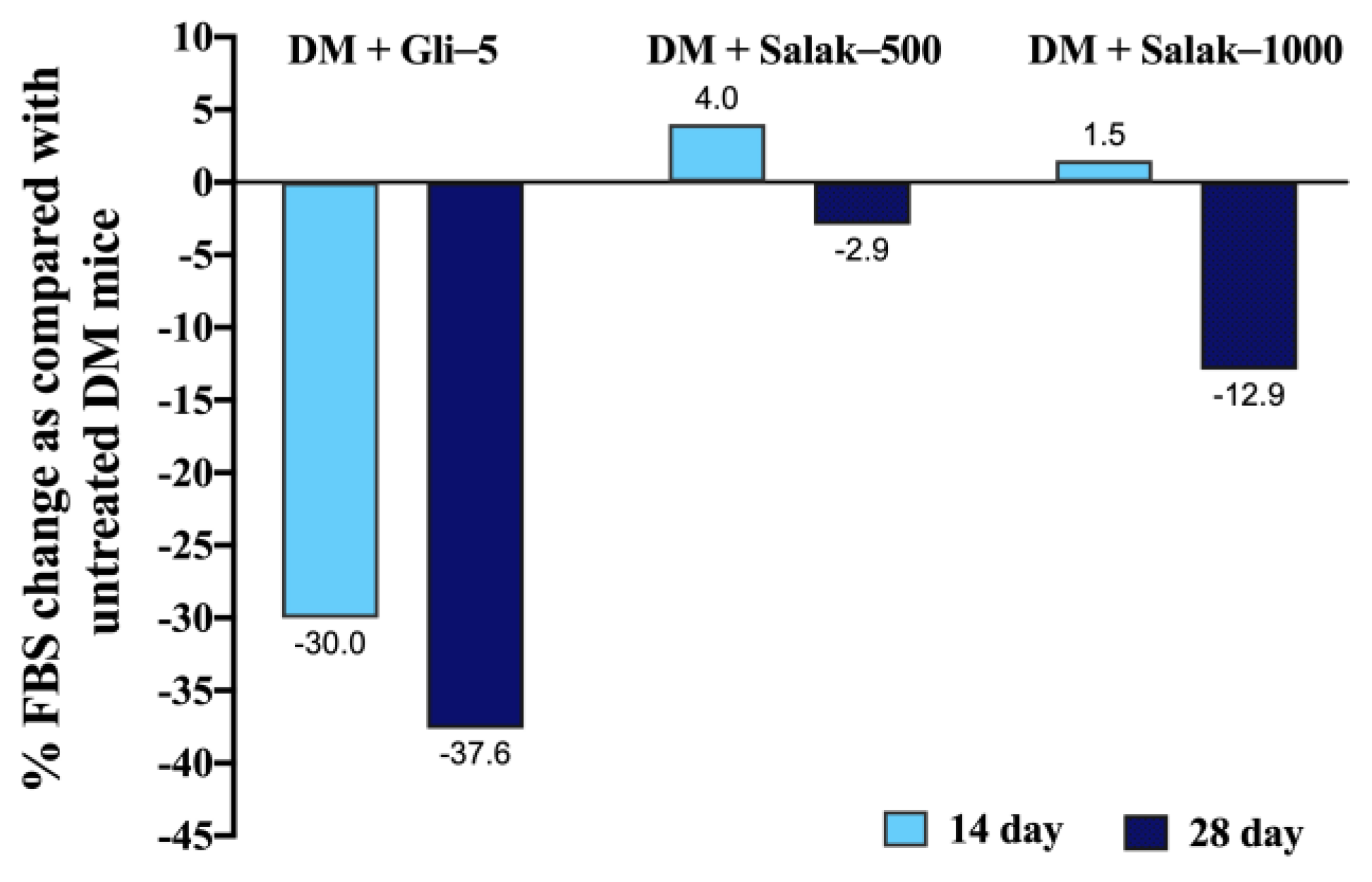

| Total Phenolic Content [mg GAE/g Extract] | FRAP Value [mg Fe2+/g Extract] | DPPH Assay IC50 [µg/mL] | ABTS Assay IC50 [µg/mL] | |
|---|---|---|---|---|
| Salak seed extract | 15.60 ± 0.79 | 17.92 ± 0.10 | 126.17 ± 1.76 | 380.35 ± 12.56 |
| Ascorbic acid | N/A | 94.71 ± 2.62 | 5.33 ± 0.1 | 11.50 ± 0.45 |
| Symptoms of Toxicity | Baseline | 1-Day | 7-Day | 14-Day | ||||
|---|---|---|---|---|---|---|---|---|
| Control | Salak | Control | Salak | Control | Salak | Control | Salak | |
| Fur and skin color | N | N | N | N | N | N | N | N |
| Eyes | N | N | N | N | N | N | N | N |
| Respiration | N | N | N | N | N | N | N | N |
| Convulsion | NF | NF | NF | NF | NF | NF | NF | NF |
| Diarrhea | NF | NF | NF | NF | NF | NF | NF | NF |
| Treatment | Mortality (Dead/Treated Mice) | Body Weight (g) | ||
|---|---|---|---|---|
| Baseline | 7-Day | 14-Day | ||
| Water (control) | 0/5 | 31.04 ± 0.92 | 32.23 ± 0.17 | 33.50 ± 0.67 |
| 2000 mg/kg salak seed extract | 0/5 | 31.26 ± 0.64 | 33.63 ± 0.35 | 33.63 ± 0.21 |
| Groups | Fasting Blood Glucose (mg/dL) | ||
|---|---|---|---|
| 0 Day | 14 Days | 28 Days | |
| NC | 81.83 ± 6.59 | 94.50 ± 4.13 | 93.67 ± 6.18 |
| DM | 315.38 ± 35.61 # | 295.20 ± 35.07 # | 436.43 ± 35.58 # |
| DM + Gli-5 | 318.29 ± 35.08 | 205.40 ± 62.95 * | 272.20 ± 47.38 * |
| DM + Salak-500 | 326.00 ± 32.94 | 307.00 ± 41.89 | 423.80 ± 50.49 |
| DM + Salak-1000 | 312.25 ± 31.43 | 299.40 ± 75.21 | 386.60 ± 34.59 |
Disclaimer/Publisher’s Note: The statements, opinions and data contained in all publications are solely those of the individual author(s) and contributor(s) and not of MDPI and/or the editor(s). MDPI and/or the editor(s) disclaim responsibility for any injury to people or property resulting from any ideas, methods, instructions or products referred to in the content. |
© 2023 by the authors. Licensee MDPI, Basel, Switzerland. This article is an open access article distributed under the terms and conditions of the Creative Commons Attribution (CC BY) license (https://creativecommons.org/licenses/by/4.0/).
Share and Cite
Sato, V.H.; Chewchinda, S.; Goli, A.S.; Sato, H.; Nontakham, J.; Vongsak, B. Oral Glucose Tolerance Test (OGTT) Evidence for the Postprandial Anti-Hyperglycemic Property of Salacca zalacca (Gaertn.) Voss Seed Extract. Molecules 2023, 28, 6775. https://doi.org/10.3390/molecules28196775
Sato VH, Chewchinda S, Goli AS, Sato H, Nontakham J, Vongsak B. Oral Glucose Tolerance Test (OGTT) Evidence for the Postprandial Anti-Hyperglycemic Property of Salacca zalacca (Gaertn.) Voss Seed Extract. Molecules. 2023; 28(19):6775. https://doi.org/10.3390/molecules28196775
Chicago/Turabian StyleSato, Vilasinee Hirunpanich, Savita Chewchinda, Arman Syah Goli, Hitoshi Sato, Jannarin Nontakham, and Boonyadist Vongsak. 2023. "Oral Glucose Tolerance Test (OGTT) Evidence for the Postprandial Anti-Hyperglycemic Property of Salacca zalacca (Gaertn.) Voss Seed Extract" Molecules 28, no. 19: 6775. https://doi.org/10.3390/molecules28196775
APA StyleSato, V. H., Chewchinda, S., Goli, A. S., Sato, H., Nontakham, J., & Vongsak, B. (2023). Oral Glucose Tolerance Test (OGTT) Evidence for the Postprandial Anti-Hyperglycemic Property of Salacca zalacca (Gaertn.) Voss Seed Extract. Molecules, 28(19), 6775. https://doi.org/10.3390/molecules28196775





